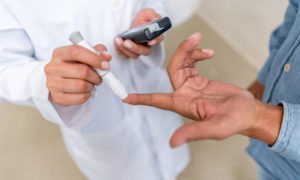By Lisa Shin, OD

July 15, 2015
On my last visit to the dentist, I received bad news. I had periodontitis, which means “inflammation around the tooth,” and is a severe gum infection that destroys soft tissue and bone. I was shocked! I had kept up with my cleaning appointments, and had practiced good hygiene, so I thought. For many years, my dentist had given me a good dental report. How could this happen, so quickly? My age and strong family history were both risk factors. People with a genetic predisposition are more likely to get gum disease. I needed immediate oral surgery. It was disruptive, traumatic and painful. Thankfully, the surgery went well. In order to avoid future complications, I must be more aggressive about my oral health.
I am not alone: Approximately 64.7 million Americans have periodontitis. According to the Centers for Disease Control and Prevention (CDC), half of Americans aged 30 or older have periodontitis. The good news is that proper hygiene and regular dental visits are effective at both preventing and managing periodontitis. My experience has renewed my commitment to prevention and to my patients. The following are a few lessons I have learned that can be applied in an optometric practice.
The power of prevention: Establish a customized preventative care and early treatment program with your patients. With the new technologies, we are in an awesome position to diagnose eye diseases, much earlier than before. Consider the Nicox Sjo test, which can detect markers for Sjogren’s syndrome. Early diagnosis and treatment can greatly improve symptoms and prevent systemic manifestations of the disease.
Steve Silberberg, OD, runs a highly innovative and unique “Macular Degeneration Diagnosis & Prevention Center” in New Jersey. He uses genetic testing to establish level of risk and a customized vitamin, lifestyle plan for his patients. “Genetic testing makes the patient an active part of his care.” says Dr. Silberberg. “Being able to assess the genetic risk, we can certainly have the patient adhere to our guidelines a lot more.” A detailed analysis of risk helps him to establish a vitamin and lifestyle plan. “Your staff has to be on the page with you. They have to know what you’re doing and why you’re doing it.” His staff members wear BluTech lenses and educate patients on the importance of UV and blue light protection.
The power of home care. Home care is just as important as in-office care. As we all know, every outcome is improved when patients are aware, informed and proactive in their own eye health. I first heard this concept from Art Epstein, OD, on the Power Hour. He applies the dental model to his highly successful Dry Eye Center of Arizona. Daily flossing and mouthwash don’t take a lot of time, but of course, can prevent gum disease and tooth decay. “You must enlist your patients in their own care,” says Dr. Epstein. He lets his dry eye patients know that daily blink exercises are required for lasting results. He has found Avenova for Daily Lid & Lash Hygiene to be a phenomenal home care product, the equivalent to tooth brushing. He also prescribes nightly moist heat masks and lid massage.
Good nutrition is also a part of home care. A healthier diet always means a better outcome. Dr. Silberberg prescribes “preventative eye vitamin therapy” for his AMD patients. But he cautions that an AREDS 2 recommendation should not be given, without appropriate genetic testing. Dr. Epstein prescribes triglyceride-based omega-3 supplements as part of his treatment plan for dry eye. Simply eating more fish can alleviate dry eye symptoms.
In my practice, I have revised my patient hand-outs for dry eye, macular degeneration and glaucoma to better emphasize prevention and home care. At the top of the checklist, there is “level of risk: low, moderate, high.” Then I list all the tests and treatments, including home care and nutrition, in simple, easy-to-understand terms. I also include a list of foods that are rich in lutein. At the end of the form, I list the schedule for follow-up care: 1 month, 3 months, 4 months and 6 months.
The power of access. The evening after my surgery, I received a phone call from my periodontist. He wanted to know how I was doing, and assured me that he and his staff were available if I needed anything. I felt miserable, of course. Throbbing pain made it difficult to concentrate, and I wondered just how long this would last. It was quite reassuring to receive a call like that!
Since then, phone calls to my patients, who need extra attention, have become a priority. It only takes a few minutes, and builds loyalty and trust. I had to send one of my patients to the retinal specialist for surgery. I called her the day after to see how she was doing. Her eye was bloodshot and she described to me, in detail, how the surgery went. “He said I couldn’t go salsa dancing for awhile. I’m really bummed about that. When can I wear my contact lenses again?” she asked. Answering simple questions gave her the reassurance she needed.
I also had a patient with severe neurological symptoms, who was visibly anxious about her condition. She had been to multiple specialists, with no answers. I did my work-up and also had no definitive diagnosis. But I called her to discuss results from the blood work and the MRI, as well as my conversations with other doctors. She commented that it had been the first time any doctor had called her and had been so involved with her care. Of course, she greatly appreciated it!
My periodontist had a skilled technician, who actually was the one who spent the most time with me! He carefully explained my condition, with all treatment options. He also gave me his cell phone number. He called in a prescription for me, long after his office had closed.
Many of my patients with more severe problems, such as advanced keratoconus, have e-mail access to me. I always get back to them with their questions and concerns. If calls and e-mails to patients are not possible, make sure that you delegate that to your staff. We are in the digital, tele-health era, where people want greater access to and immediate availability of care.
What are you doing to emphasize prevention and home care in your practice? What are some of the ways you can be more accessible and available to your patients?
Lisa Shin, OD, is the owner of Los Alamos Family Eyecare, P.C., in Los Alamos, N. M. To contact her: lshin87@gmail.com

























